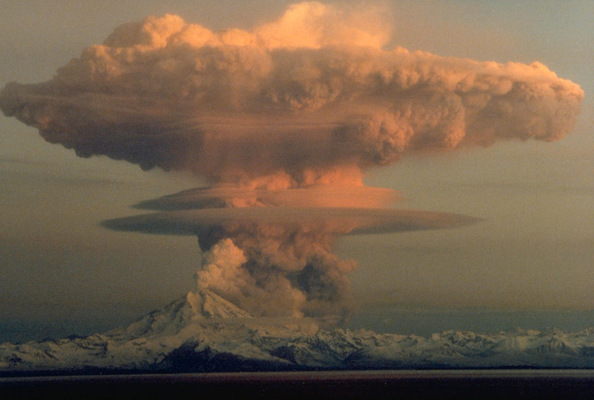
by Terry Gerlach Friday, January 20, 2012

Alaska's Mount Redoubt, during a 1990 eruption. USGS
“Volcanoes add far more carbon dioxide to the oceans and atmosphere than humans.” So says geologist Ian Plimer of the University of Adelaide in his 2009 best seller “Heaven and Earth: Global Warming — the Missing Science.” With this assertion, Plimer brings volcanic carbon dioxide degassing front and center in the climate change debate, reviving and reinforcing this wildly mistaken notion.
Although discussions of volcanic carbon dioxide emissions make up less than 5 percent of “Heaven and Earth’s” text, the alleged predominance of volcanic over human carbon dioxide emissions is one of its most publicized takeaway messages. And one that will reverberate in the media and blogosphere — no matter how vociferously professionals who investigate volcanic carbon dioxide emissions bristle and huff about how appallingly at odds Plimer’s claim is with our research findings.
The treatment of volcanic versus anthropogenic carbon dioxide emissions in this book illustrates one of the pathways by which myths, misrepresentations and spurious information get injected into the climate change debate. Like several climate skeptic publications, blogs and websites, “Heaven and Earth” does not provide the published estimates of the present-day global carbon dioxide emission rate from volcanoes. These estimates are, ironically, “the missing science” of a book professing to rectify supposed excesses of missing science — a book that appears impressively authoritative by citing a mountain of scientific literature.
Several studies containing these estimates are among its 2,311 citations, but the estimates themselves are never divulged. Moreover, the book and other purveyors of this myth never explain, nor cite sources that explain, how it is known that volcanoes wholly outdo humans in adding carbon dioxide to the oceans and atmosphere.
Published estimates based on research findings of the past 30 years for
present-day global emission rates of carbon dioxide from subaerial and
submarine volcanoes range from about 150 million to 270 million metric
tons of carbon dioxide per year, with an average of about 200 million
metric tons,
These global volcanic estimates are utterly dwarfed by carbon dioxide
emissions from fossil fuel burning, cement production, gas flaring and
land use changes; these emissions accounted for some 36,300 million
metric tons of carbon dioxide in 2008, according to an international
study published in the December 2009 issue of Nature Geoscience. Even if
you take the highest estimate of volcanic carbon dioxide emissions, at
270 million metric tons per year, human-emitted carbon dioxide levels
are more than 130 times higher than volcanic emissions.
Occasionally, scaled-down versions of the myth surface — for example, “Volcanoes produce more carbon dioxide than the world’s cars and industries combined.” The truth is that data from the Carbon Dioxide Information and Analysis Center of Oak Ridge National Laboratory and the International Energy Agency indicate that light-duty vehicles (cars, pickup trucks, SUVs, vans, wagons) contribute about 3,040 million metric tons of carbon dioxide per year, and industry adds another 6,100 million metric tons of carbon dioxide. The combined output is about 35 times greater than estimates of global volcanic carbon dioxide output.
Another version of the myth is the all-powerful but poorly understood volcanic source. For example, “Heaven and Earth” describes submarine volcanoes as “poorly understood because of the lack of continuous observation and measurement,” yet “carbon dioxide from tens of thousands of submarine hot springs associated with these submarine basalt volcanoes quietly dissolves in the cold high-pressure deep ocean water.” Then, this statement: “One hot spring can release far more carbon dioxide than a 1,000-megawatt coal-fired power station yet they are neither seen nor measured.” If this is neither seen nor measured, then how does Plimer know how much carbon dioxide a hot spring emits? No supporting evidence or references are offered. In fact, there are measurements on the carbon dioxide flux of mid-ocean ridge hydrothermal fluids, but they do not support the power station comparison.
According to the Environmental Protection Agency, the average carbon dioxide emission rate from coal-fired power generation in the United States is 1.02 metric tons per megawatt-hour. So, 1.02 metric tons of carbon dioxide per megawatt-hour, times 1,000 megawatts, times 24 hours per day, times 365 days per year, equals 8,935,200 metric tons of carbon dioxide per year. Thus, one of these submarine hot springs allegedly generates “far more” than 9 million metric tons of carbon dioxide per year — or far more than three times the annual baseline output of Kilauea Volcano in Hawaii! Just 12 of these hot springs would exceed carbon dioxide emission rate estimates for the entire 65,000-kilometer-long mid-ocean ridge system.
To scale up volcanic carbon dioxide output to the current anthropogenic level would require adding thousands of volcanoes to the 50 to 60 normally active volcanoes of the subaerial landscape and more than a hundred additional mid-ocean ridge systems to the seafloor.
Global volcanic carbon dioxide emission estimates contain uncertainties and are variable, but there is virtually no doubt that volcanism adds far less carbon dioxide to the oceans and atmosphere than humans.
© 2008-2021. All rights reserved. Any copying, redistribution or retransmission of any of the contents of this service without the expressed written permission of the American Geosciences Institute is expressly prohibited. Click here for all copyright requests.